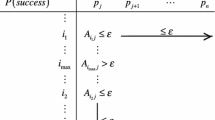Abstract
Chernoff bounds are a powerful application of the Markov inequality to produce strong bounds on the tails of probability distributions. They are often used to bound the tail probabilities of sums of Poisson trials, or in regression to produce conservative confidence intervals for the parameters of such trials. The bounds provide expressions for the tail probabilities that can be inverted for a given probability/confidence to provide tail intervals. The inversions involve the solution of transcendental equations and it is often convenient to substitute approximations that can be exactly solved e.g. by the quadratic equation. In this paper we introduce approximations for the Chernoff bounds whose inversion can be exactly solved with a quadratic equation, but which are closer approximations than those adopted previously.




Similar content being viewed by others
Notes
A feature of Chernoff bounds is that they only depend on the (expected) number of observations rather than making any explicit use of the number of trials. This means that the same \(\delta \) values will be returned for any example where \(\mu =200\) e.g. 1000 trials with \(\mathbb P(X_i=1)=0.2\).
We again observe that the Chernoff bounds are computed using only the number of observed successes and do not directly depend on the number of trials.
References
Bernstein S (1924) On a modification of Chebyshev’s inequality and of the error formula of Laplace. Uchenye Zapiski Nauch-Issled Kaf Ukraine Sect Math 1:38–48
Bindel N, Schanck JM (2020) Decryption failure is more likely after success. PQCrypto 2020 (LNCS 12100), pp 206–225
Dubhashi D, Panconesi A (2009) Concentration of measure for the analysis of randomized algorithms, 1st edn. Cambridge University Press, Cambridge
Mitzenmacher M, Upfal E (2017) Probability and computing: randomized algorithms and probabilistic analysis, 2nd edn. Cambridge University Press, Cambridge
Pirandola S (2021) Limits and security of free-space quantum communications. Phys Rev Res 3:013279
Zhang Z, Zhao Q, Razavi M, Ma X (2017) Improved key rate bounds for practical decoy-state quantum key distribution systems. Phys Rev A 95:012333
Acknowledgements
The author is very grateful to Sophie Stevens for discussions on this work and also to an anonymous referee for several very useful suggestions for its improvement.
Author information
Authors and Affiliations
Corresponding author
Additional information
Publisher's Note
Springer Nature remains neutral with regard to jurisdictional claims in published maps and institutional affiliations.
Rights and permissions
About this article
Cite this article
Shiu, D. Efficient computation of tight approximations to Chernoff bounds. Comput Stat 38, 133–147 (2023). https://doi.org/10.1007/s00180-022-01219-2
Received:
Accepted:
Published:
Issue Date:
DOI: https://doi.org/10.1007/s00180-022-01219-2




